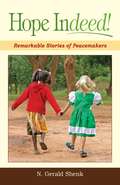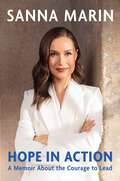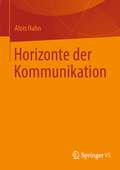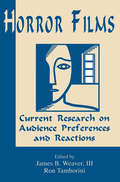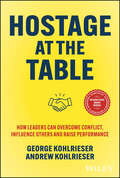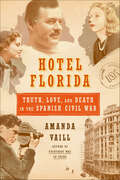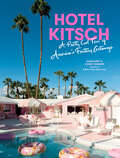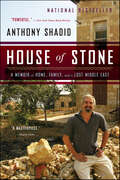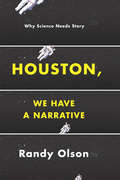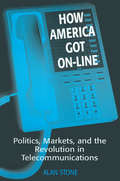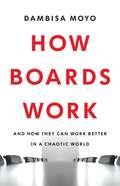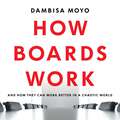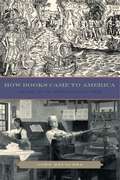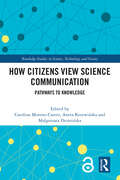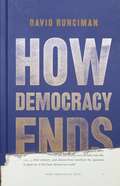- Table View
- List View
Hope Indeed: Remarkable Stories Of Peacemakers
by N. ShenkGerald Shenk has traveled to and lived in many difficult places. He goes to teach-and to spot people who act out of hope. When he began to feel fortified by what he discovered, even foolishly rich, he wrote what he had witnessed and heard for the rest of us. Hope Indeed! is his collection of stories of stunningly ordinary people behaving with extraordinary hope. Here are the stories of- Ned Wyse, a farmer/pastor in Michigan, chosen randomly for a violent beating by some neighborhood kids, and what he did about it. The Palestinian parents who gave their young murdered son's organs to ill Jewish children. The Amish, who subverted the vicious violation of their innocent children in the Nickel Mines school by refusing to multiply the horror, and instead offered forgiveness and generosity. Jewish Cantor Michael Weisser and his family who took carry-out food to the white supremacists who had harassed them mercilessly. The German Lutheran pastor couple who offered their home to recently desposed and homeless Erich Honecker, who had ruthlessly ruled East Germany. Brother Ivo who kept bringing former Catholic and Muslim neighbors together as war escalated in Bosnia. Says Shenk, "Here are stories to rehearse if we want to become people who subvert vengeance with kindness."
Hope in Action: A Memoir About the Courage to Lead
by Sanna MarinSanna Marin, the world&’s youngest prime minister when she took office, shares her inspiring path to leadership and encourages readers to effect change in the world.In Hope in Action, Sanna Marin takes readers on the extraordinary journey of her trailblazing career and exemplifies a new kind of leadership. When she became prime minister of Finland at just thirty-four years old, Marin was the youngest world leader at the time, captivating international attention with her progressive ideas and decisive action in a crisis. Marin&’s story is one of resilience and hope. The first in her family to attend university, she broke barriers to become a highly respected role model for many young girls and women. Her term as prime minister saw historic milestones—she led Finland through the COVID-19 pandemic, and her government implemented reforms addressing climate change, social justice, and equality. She helped the country navigate neighboring Russia&’s devastating full-scale invasion of Ukraine and Finland&’s rapid joining of NATO—the swiftest entry for any country in the alliance&’s history. Through vivid retellings of her experiences, Marin shares how she overcame significant political challenges and how she coped with her personal life becoming public, as in an incident that sparked a media frenzy and prompted women around the world to express their support. Hope in Action is more than a memoir—it&’s a rallying cry. Marin urges the next generation of leaders to bring their full selves to the job. Her story is an empowering testament to the opportunities we have to effect real change.
Horace Walpole (The A. W. Mellon Lectures in the Fine Arts #9)
by Wilmarth Sheldon LewisAn illuminating biographical study of the eighteenth-century English man of letters and patron of the artsHorace Walpole (1717–1797) was a collector, printer, novelist, arbiter of taste, and renowned writer of letters. In this book, eminent scholar Wilmarth Sheldon Lewis provides an unprecedented look at the life and work of one of England’s greatest men of letters. Lewis sheds light on Walpole’s relationships with his family and friends, his politics, his writings and printmaking activities, and his correspondence. Featuring portraits of Walpole, his relatives, and friends; images of Walpole's sketches and manuscripts; pages from books printed at Walpole’s Strawberry Hill Press; and views and plans of Strawberry Hill, the house, its rooms and furnishings, and its grounds, and accompanied by Lewis’s extensive annotations, this book provides an invaluable history of an extraordinary man.
Horizonte der Kommunikation
by Alois HahnÜber Kommunikation ist viel kommuniziert worden. Watzlawick schreibt sogar, man könne nicht nicht kommunizieren. Die hier vorgelegte Aufsatzsammlung vereint eine Reihe von Beiträgen, die im Laufe der Jahre in höchst unterschiedlichen Kontexten entstanden sind. Das Thema Kommunikation war oft nicht das Zentrum. Viele Texte entstanden ursprünglich auch in interdisziplinären Kolloquien. Die Arbeiten hier zusammenzufügen entspringt der Absicht, eine vorher teilweise latente Sinnlinie freizulegen. Man könnte von einer Transformation von Publikationen in Spolien sprechen. Das Hauptanliegen ist, einige bislang eher wenig behandelte Horizonte des Themas ins Auge zu fassen, Ränder sozusagen oder Sonderaspekte. Dieser Horizont erscheint bisweilen als Kaleidoskop.
Horror Films: Current Research on Audience Preferences and Reactions (Routledge Communication Series)
by Iii James B. Weaver Ron TamburiniWhy do so many of us enjoy being told frightening stories? What are some of the consequences that result from such exposure? In light of the considerable popularity of horror films over the last three decades, these questions have become the focus of growing attention for many scholars. However, research on audience preferences for, and reactions to, horror films has been performed eclectically by investigators from varied theoretical and methodological backgrounds. As a result, the information has not been effectively integrated. This volume was written to address this problem and to position the study of audience responses to frightening fiction as a significant research topic.
Horses, Humans, and Love
by Tim HayesA remarkable follow-up from the author ofRiding Home: The Power of Horses to HealIf you were asked to make a list of all the people you love, how long would it take until you put yourself on the list?Years ago, when asked this question, Tim Hayes didn't have an answer. But today, after working with horses for more than 30 years, he not only puts his name on the list, he puts it first.When humans learn to love themselves, they become more compassionate. They become better parents, children, husbands, wives, partners, and coworkers. In fact, they have more successful relationships in general.Over the course of his career learning about horses and horsemanship, and eventually teaching it to others, Hayes gained an understanding of the profound social skills evident in horse relationships. This is known by many as herd dynamics and includes what he names as 10 specific qualities:AcceptanceTolerancePatienceUnderstandingKindnessHonestyTrustRespectForgivenessCompassionInHorses, Humans, and Love, his follow-up toRiding Home—the book Robert Redford called &“A beautiful volume of healing and love between man and nature&” and Temple Grandin said was &“Essential reading&”—Hayes explains how and why when humans emulate these 10 qualities of herd dynamics witnessed in horses in their own human relationships, they naturally express and thus demonstrate the true altruistic meaning of what we call &“love,&” both for others, and for ourselves.Through his personal journey and inspiring stories of those he has worked with through the years, Hayes reveals how horses can teach us all how to compassionately reconnect with our shared global humanity and put an end to self-created, antagonistic, superficial human differences such as race, religion, nationality, wealth, and ideology. He shows us how horses have the ability to instantly remind us that we all share the same world, share the same fears and desires, and more than anything else, desperately desire to get along with each other.In his thoughtful descriptions of his own experience and research, Hayes illustrates his spiritual and philosophical struggles to understand the state of the world today and how we each can work in simple yet impactful ways to make it better. His conclusions, having reflected upon and shared what he has learned through the horse, leave readers with an infectious optimism one might even call hope. His book, a gentle treatise for change from a remarkable horseman, will be enjoyed by all those seeking to improve their own lives and that of our global community.
Hostage at the Table: How Leaders Can Overcome Conflict, Influence Others and Raise Performance
by George Kohlrieser Andrew KohlrieserDiscover how to boldly lead, address conflict and inspire others in your business and personal life In the newly revised second edition of Hostage at the Table: How Leaders Can Overcome Conflict, Influence Others and Raise Performance, clinical psychologist, distinguished leadership professor, and veteran hostage negotiator George Kohlrieser comes together with his son Andrew Kohlrieser, an experienced leadership, negotiation and conflict resolution consultant, to deliver another incisive and practical discussion of how to use the proven psychological techniques used in hostage negotiations to enhance your leadership skills both professionally and personally. Step-by-step, the authors explain the seven key factors that anyone can use to remove the obstacles that stand in the way of resolving interpersonal, business and leadership issues. You’ll: ● Discover proven techniques for interpersonal and business conflict management ● Become a secure base for your team, establish trust, and learn how to bond with anyone ● Explore how to identify where you are holding yourself hostage in your life and learn how to reclaim your agency and move toward a more empowered future A fascinating and hands-on presentation of how to take the lessons drawn from tense, high-stakes hostage situations and apply them to the interpersonal and leadership problems you face every day, Hostage at the Table is a must-read resource for managers, executives, entrepreneurs, founders, and other business leaders seeking the latest research, the most engrossing real-world negotiation examples, and the most effective solutions.
Hot Seat: The Startup CEO Guidebook
by Dan ShapiroWhat avoidable problem destroys more young startups than any other?Why is it a mistake to ask for introductions to investors?When do you play the CEO card?Should you sell out?Author and four-time founder/CEO Dan Shapiro tells the stories of dozens of startups whose companies lived and died by the advice in these pages. From inception to destruction and triumph to despair, this rollercoaster read takes aspiring entrepreneurs from the highs of billion-dollar payouts and market-smashing success to the depths of impostor syndrome and bankruptcy.Hot Seat is divided into the five phases of the startup CEO experience:Founding explains how to formulate your idea, allocate equity, and not argue yourself to deathFunding provides the keys to venture capital, angels, and crowdfunding, plus clear advice on which approach to chooseLeadership lays out a path to build a strategy and culture for your team that will survive good times and badManagement reveals how to manage your board, argue with your team, and play the CEO cardEndgame explains how to finish a company's existence with grace, wealth, and minimal litigation
Hotel Florida: Truth, Love, and Death in the Spanish Civil War
by Amanda VaillA spellbinding story of love amid the devastation of the Spanish Civil WarMadrid, 1936. In a city blasted by a civil war that many fear will cross borders and engulf Europe—a conflict one writer will call "the decisive thing of the century"—six people meet and find their lives changed forever. Ernest Hemingway, his career stalled, his marriage sour, hopes that this war will give him fresh material and new romance; Martha Gellhorn, an ambitious novice journalist hungry for love and experience, thinks she will find both with Hemingway in Spain. Robert Capa and Gerda Taro, idealistic young photographers based in Paris, want to capture history in the making and are inventing modern photojournalism in the process. And Arturo Barea, chief of the Spanish government's foreign press office, and Ilsa Kulcsar, his Austrian deputy, are struggling to balance truth-telling with loyalty to their sometimes compromised cause—a struggle that places both of them in peril. Beginning with the cloak-and-dagger plot that precipitated the first gunshots of the war and moving forward month by month to the end of the conflict. Hotel Florida traces the tangled and disparate wartime destinies of these three couples against the backdrop of a critical moment in history: a moment that called forth both the best and the worst of those caught up in it. In this noir landscape of spies, soldiers, revolutionaries, and artists, the shadow line between truth and falsehood sometimes became faint indeed—your friend could be your enemy and honesty could get you (or someone else) killed. Years later, Hemingway would say, "It is very dangerous to write the truth in war, and the truth is very dangerous to come by." In Hotel Florida, from the raw material of unpublished letters and diaries, official documents, and recovered reels of film, the celebrated biographer Amanda Vaill has created a narrative of love and reinvention that is, finally, a story about truth: finding it, telling it, and living it—whatever the cost.*INCLUDES 16 PAGES OF BLACK-AND-WHITE PHOTOGRAPHS
Hotel Kitsch: A Pretty Cool Tour of America's Fantasy Getaways
by Margaret Bienert Corey BienertA visual celebration of the best fantasy suites and honeymoon hotels across America and beyond, from the creators of A Pretty Cool Hotel Tour In 1963, the savvy owners of the Cove Haven Resort in the Poconos unveiled their heart-shaped tub. Like Elvis Presley and Playboy magazine, it launched a postwar phenomenon that defined a new era of pop pleasure: the honeymoon hotel. Destinations across the country were soon racing to catch up, installing not just heart-shaped tubs but all types of over-the-top design flourishes, from pink shag carpeting to immersive worlds worthy of a Broadway stage set, in order to create a sense of romance, fantasy, even adventure. From the photographers and inveterate travelers behind the social media sensation A Pretty Cool Hotel Tour, Hotel Kitsch celebrates dozens of creative, nostalgic, one-of-a-kind hotels that span the heart of the Poconos and across the United States to Mexico, Spain, and the UK. Discover, in the middle of Iowa, a jungle room with fake trees and foliage surrounding the bed as if it had taken its cue from Where the Wild Things Are. Or Jules&’ Undersea Lodge in Key Largo where the rooms are reached by scuba diving. An Arctic Cave room at a hotel in Kentucky with its carved blue walls and not a window to be found. And on the California coast, the iconic Madonna Inn featuring 110 rooms, each themed and no two alike. Along the way, authors Margaret and Corey Bienert uncover too many wild details to mention, including unconventional beds (a Cadillac, a clamshell, a sandwich), mirrors on mirrors on mirrors, in-room swimming pools, full suits of armor, and fiber-optic star ceilings. While it&’s not a travel guide, every destination in Hotel Kitsch is open for business. Time to check in.
Hotel Mariachi: Urban Space and Cultural Heritage in Los Angeles (Querencias Series)
by Enrique R. Lamadrid Catherine L. KurlandIn Boyle Heights, gateway to East Los Angeles, sits the 1889 landmark &“Hotel Mariachi,&” where musicians have lived and gathered on the adjacent plaza for more than half a century. This book is a photographic and ethnographic study of the mariachis, Mariachi Plaza de Los Angeles, and the neighborhood. The newly restored brick hotel embodies a triumphant struggle of preservation against all odds, and its origins open a portal into the Mexican pueblo&’s centuries-old multiethnic past.Miguel Gandert&’s compelling black-and-white images document the hotel and the vibrant mariachi community of the &“Garibaldi Plaza of Los Angeles.&” The history of Hotel Mariachi is personal to Catherine López Kurland, a descendant of the entrepreneur who built it, and whose family&’s Californio roots will fascinate anyone interested in early Los Angeles or Mexican American history. Enrique Lamadrid explores mariachi music, poetry, and fiestas, and the part Los Angeles played in their development, delving into the origins of the music and offering a deep account of mariachi poetics. Hotel Mariachi is a unique lens through which to view the history and culture of Mexicano California, and provides touching insights into the challenging lives of mariachi musicians.
House of Stone: A Memoir of Home, Family, and a Lost Middle East
by Anthony Shadid“Wonderful . . . One of the finest memoirs I’ve read.” — Philip Caputo, Washington PostIn the summer of 2006, racing through Lebanon to report on the Israeli invasion, Anthony Shadid found himself in his family’s ancestral hometown of Marjayoun. There, he discovered his great-grandfather’s once magnificent estate in near ruins, devastated by war. One year later, Shadid returned to Marjayoun, not to chronicle the violence, but to rebuild in its wake.So begins the story of a battle-scarred home and a journalist’s wounded spirit, and of how reconstructing the one came to fortify the other. In this bittersweet and resonant memoir, Shadid creates a mosaic of past and present, tracing the house’s renewal alongside the history of his family’s flight from Lebanon and resettlement in America around the turn of the twentieth century. In the process, he memorializes a lost world and provides profound insights into a shifting Middle East. This paperback edition includes an afterword by the journalist Nada Bakri, Anthony Shadid’s wife, reflecting on his legacy.“A poignant dedication to family, to home, and to history . . . Breathtaking.” — San Francisco Chronicle“Entertaining, informative, and deeply moving . . . House of Stone will stand a long time, for those fortunate enough to read it.” — Telegraph (London)
Houston, We Have a Narrative: Why Science Needs Story
by Randy OlsonAsk a scientist about Hollywood, and you'll probably get eye rolls. But ask someone in Hollywood about science, and they'll see dollar signs: moviemakers know that science can be the source of great stories, with all the drama and action that blockbusters require. That's a huge mistake, says Randy Olson: Hollywood has a lot to teach scientists about how to tell a story--and, ultimately, how to do science better. With Houston, We Have a Narrative, he lays out a stunningly simple method for turning the dull into the dramatic. Drawing on his unique background, which saw him leave his job as a working scientist to launch a career as a filmmaker, Olson first diagnoses the problem: When scientists tell us about their work, they pile one moment and one detail atop another moment and another detail--a stultifying procession of "and, and, and. " What we need instead is an understanding of the basic elements of story, the narrative structures that our brains are all but hardwired to look for--which Olson boils down, brilliantly, to "And, But, Therefore," or ABT. At a stroke, the ABT approach introduces momentum ("And"), conflict ("But"), and resolution ("Therefore")--the fundamental building blocks of story. As Olson has shown by leading countless workshops worldwide, when scientists' eyes are opened to ABT, the effect is staggering: suddenly, they're not just talking about their work--they're telling stories about it. And audiences are captivated. Written with an uncommon verve and enthusiasm, and built on principles that are applicable to fields far beyond science, Houston, We Have a Narrative has the power to transform the way science is understood and appreciated, and ultimately how it's done.
How About Never—Is Never Good for You?: My Life in Cartoons
by Bob MankoffMemoir in cartoons by the longtime cartoon editor of The New YorkerPeople tell Bob Mankoff that as the cartoon editor of The New Yorker he has the best job in the world. Never one to beat around the bush, he explains to us, in the opening of this singular, delightfully eccentric book, that because he is also a cartoonist at the magazine he actually has two of the best jobs in the world. With the help of myriad images and his funniest, most beloved cartoons, he traces his love of the craft all the way back to his childhood, when he started doing funny drawings at the age of eight. After meeting his mother, we follow his unlikely stints as a high-school basketball star, draft dodger, and sociology grad student. Though Mankoff abandoned the study of psychology in the seventies to become a cartoonist, he recently realized that the field he abandoned could help him better understand the field he was in, and here he takes up the psychology of cartooning, analyzing why some cartoons make us laugh and others don't. He allows us into the hallowed halls of The New Yorker to show us the soup-to-nuts process of cartoon creation, giving us a detailed look not only at his own work, but that of the other talented cartoonists who keep us laughing week after week. For desert, he reveals the secrets to winning the magazine's caption contest. Throughout How About Never--Is Never Good for You?, we see his commitment to the motto "Anything worth saying is worth saying funny."
How America Got On-line: Politics, Markets, and the Revolution in Telecommunication
by Alan StoneThe telecommunications industry is the fastest growing sector of the US economy. This interdisciplinary study of technopolitical economics traces the industry's evolution from the invention of the telephone to the development of hypercommunications. Primary focus is on AT&T and its rivals.
How Australia Decides
by Sally YoungIn recent years, the Australian media have come under fire for their reporting of politics and election campaigns. Political reporting is said to be too influenced by commercial concerns, too obsessed with gossip and scandal, and too focused on trivia and 'sound bites' at the expense of serious issues. There are accusations of bias, sensationalism, 'lazy' journalism and 'horse-race' reporting that is obsessed with opinion polls. How Australia Decides is the first book to put these allegations to the test. Based on a four-year empirical study, Sally Young reports the results of the only systematic, historical and in-depth analysis of Australian election reporting. This groundbreaking book shows how election reporting has changed over time, and how political news audiences, news production and shifts in political campaigning are influencing media content, Ai with profound implications for Australian democracy.
How Boards Work: And How They Can Work Better in a Chaotic World
by Dambisa Moyo'Highly instructive . . . provides thoughtful analysis' Financial Times'Exactly what any prospective-or sitting-board member needs' Arianna Huffington'A must read . . . highly engaging . . . an indispensable guide to how boards function, malfunction, and, most importantly, should operate better' Mohamed A. El-ErianCorporate boards are under great pressure. Scandals and malpractice at companies like GE, Theranos and WeWork have raised justified questions among regulators, shareholders, and the public about the quality of corporate governance. Boards face ever-louder demands to weigh in on questions of climate change, racial and gender equity, data privacy, and other social issues that range far beyond their traditional mandate: choosing the CEO and endorsing corporate strategy.In HOW BOARDS WORK, prizewinning economist, veteran board director, and bestselling author Dambisa Moyo offers an insider's view of corporate boards as they are buffeted by the turbulence of our times. Drawing on her decade of experience serving on corporate boards, Moyo lays out what it is that boards actually do, and she outlines how they must adapt to survive the challenges of coming years. Corporations need boards that are more transparent, more knowledgeable, more diverse, and more deeply involved in setting the strategic course of the companies they lead.HOW BOARDS WORK is an urgent road map for how boards can steer companies through tomorrow's challenges and ensure they thrive to benefit their employees, shareholders, and society at large.
How Boards Work: And How They Can Work Better in a Chaotic World
by Dambisa Moyo'Highly instructive . . . provides thoughtful analysis' Financial Times'Exactly what any prospective-or sitting-board member needs' Arianna Huffington'A must read . . . highly engaging . . . an indispensable guide to how boards function, malfunction, and, most importantly, should operate better' Mohamed A. El-ErianCorporate boards are under great pressure. Scandals and malpractice at companies like GE, Theranos and WeWork have raised justified questions among regulators, shareholders, and the public about the quality of corporate governance. Boards face ever-louder demands to weigh in on questions of climate change, racial and gender equity, data privacy, and other social issues that range far beyond their traditional mandate: choosing the CEO and endorsing corporate strategy.In HOW BOARDS WORK, prizewinning economist, veteran board director, and bestselling author Dambisa Moyo offers an insider's view of corporate boards as they are buffeted by the turbulence of our times. Drawing on her decade of experience serving on corporate boards, Moyo lays out what it is that boards actually do, and she outlines how they must adapt to survive the challenges of coming years. Corporations need boards that are more transparent, more knowledgeable, more diverse, and more deeply involved in setting the strategic course of the companies they lead.HOW BOARDS WORK is an urgent road map for how boards can steer companies through tomorrow's challenges and ensure they thrive to benefit their employees, shareholders, and society at large.
How Books Came to America: The Rise of the American Book Trade (Penn State Series in the History of the Book #17)
by John HruschkaAnyone who pays attention to the popular press knows that the new media will soon make books obsolete. But predicting the imminent demise of the book is nothing new. At the beginning of the twentieth century, for example, some critics predicted that the electro-mechanical phonograph would soon make books obsolete. Still, despite the challenges of a century and a half of new media, books remain popular, with Americans purchasing more than eight million books each day. In How Books Came to America, John Hruschka traces the development of the American book trade from the moment of European contact with the Americas, through the growth of regional book trades in the early English colonial cities, to the more or less unified national book trade that emerged after the American Civil War and flourished in the twentieth century. He examines the variety of technological, historical, cultural, political, and personal forces that shaped the American book trade, paying particular attention to the contributions of the German bookseller Frederick Leypoldt and his journal, Publishers Weekly.Unlike many studies of the book business, How Books Came to America is more concerned with business than it is with books. Its focus is on how books are manufactured and sold, rather than how they are written and read. It is, nevertheless, the story of the people who created and influenced the book business in the colonies and the United States. Famous names in the American book trade—Benjamin Franklin, Robert Hoe, the Harpers, Henry Holt, and Melvil Dewey—are joined by more obscure names like Joseph Glover, Conrad Beissel, and the aforementioned Frederick Leypoldt. Together, they made the American book trade the unique commercial institution it is today.
How Circuits Work: Amplifiers, Filters, Audio and Control Electronics (Synthesis Lectures on Engineering, Science, and Technology)
by Stanislaw RaczynskiThis book helps readers understand the basic concepts of electronic circuits. The emphasis is on amplifiers, filters and audio circuits. Other applications such as oscillators, multivibrators, logic and control circuits are also included. Although basic concepts are presented with the necessary theoretical background, the author uses descriptions of basic electronic circuits in a very compact form and the circuit functions are described in a very accessible manner.
How Citizens View Science Communication: Pathways to Knowledge (Routledge Studies in Science, Technology and Society)
by Carolina Moreno-Castro Aneta Krzewińska Małgorzata DzimińskaScience communication aims at the successful sharing and explanation of sciencerelated topics to a wider audience. In order to enhance communication between science and society, a better understanding of citizens’ habits and perceptions is needed. Therefore, it is vital to understand how citizens acquire knowledge about science- related issues, how this knowledge affects their beliefs, opinions and perceptions, and what sources of information they choose to learn about science – and how they assess their reliability. This book addresses these questions, based on the analyses of public consultations data from Italy, Poland, Portugal, Slovakia and Spain, concerned with the science communication of issues including climate change, vaccines, complementary and alternative medicine (CAM) and genetically modified organisms (GMOs). Sharing experiences of how to engage citizens in public consultation, it provides insights into the mobilisation of interest in science and offers recommendations on how to improve science communication.
How Cybersecurity Really Works: A Hands-On Guide for Total Beginners
by Sam GrubbCybersecurity for Beginners is an engaging introduction to the field of cybersecurity. You'll learn how attackers operate, as well as how to defend yourself and organizations against online attacks.You don&’t need a technical background to understand core cybersecurity concepts and their practical applications – all you need is this book. It covers all the important stuff and leaves out the jargon, giving you a broad view of how specific attacks work and common methods used by online adversaries, as well as the controls and strategies you can use to defend against them. Each chapter tackles a new topic from the ground up, such as malware or social engineering, with easy-to-grasp explanations of the technology at play and relatable, real-world examples. Hands-on exercises then turn the conceptual knowledge you&’ve gained into cyber-savvy skills that will make you safer at work and at home. You&’ll explore various types of authentication (and how they can be broken), ways to prevent infections from different types of malware, like worms and viruses, and methods for protecting your cloud accounts from adversaries who target web apps. You&’ll also learn how to: • Use command-line tools to see information about your computer and network • Analyze email headers to detect phishing attempts • Open potentially malicious documents in a sandbox to safely see what they do • Set up your operating system accounts, firewalls, and router to protect your network • Perform a SQL injection attack by targeting an intentionally vulnerable website • Encrypt and hash your files In addition, you&’ll get an inside look at the roles and responsibilities of security professionals, see how an attack works from a cybercriminal&’s viewpoint, and get first-hand experience implementing sophisticated cybersecurity measures on your own devices.
How Democracy Ends
by David RuncimanHow will democracy end? And what will replace it? A preeminent political scientist examines the past, present, and future of an endangered political philosophySince the end of World War II, democracy's sweep across the globe seemed inexorable. Yet today, it seems radically imperiled, even in some of the world's most stable democracies. How bad could things get?In How Democracy Ends, David Runciman argues that we are trapped in outdated twentieth-century ideas of democratic failure. By fixating on coups and violence, we are focusing on the wrong threats. Our societies are too affluent, too elderly, and too networked to fall apart as they did in the past. We need new ways of thinking the unthinkable--a twenty-first-century vision of the end of democracy, and whether its collapse might allow us to move forward to something better.A provocative book by a major political philosopher, How Democracy Ends asks the most trenchant questions that underlie the disturbing patterns of our contemporary political life.
How Digital Communication Technology Shapes Markets
by Swati BhattThis Palgrave Pivot explores how communication technology such as the Internet has changed the nature of trade, focusing especially on economy-wide reductions in company size (granularity) and the role of retailers (disintermediation). By increasing access to comparative data, influencing conceptions of time, and reducing the number of intermediaries between creator and consumer, technological connectivity is changing the very definition of competition. In the new network economy, disintermediation and granularity are turning cooperative information gathering and sharing into a vital market institution. To exemplify the effects of communication technology, Bhatt focuses on two markets with particularly powerful effects on the economy: labor and education, and CIME (communication, information services, media, and entertainment). Mobile connectivity is radically changing the extent, capabilities, and operations of these markets, both in terms of the services they provide and how they interact with consumers. Bhatt also explores how these benefits intersect with new concerns about privacy and security when the line between public and private information is becoming ever more fluid.
How Disruption Brought Order: The Story of a Winning Strategy in the World of Advertising
by Jean-Marie Dru“Quite simply and without a shadow of a doubt the best book about advertising ever written . . . a treasure trove of brilliant examples and anecdotes.” ―Donald Gunn, Founder, The Gunn ReportIn his previous bestselling books, global advertising icon Jean-Marie Dru explored the visionary, innovative techniques that have become a hallmark of TBWA Worldwide campaigns. Now he gives a first-hand account of how the bold methods of disruption launched TBWA to the forefront of international advertising. Here he shares personal insights and anecdotes about his life in advertising as well as lessons learned, revealing how client campaigns for Nissan, Adidas, and the Apple iPhone became such unqualified successes. Both a fascinating business memoir and a practical guide to harnessing the power of disruption, this book offers a look at the cutting edge of modern advertising.“In this honest, fast-paced, and endlessly useful book, Jean-Marie Dru, a disruptive thinker who has helped so many great companies redefine their brands and marketing messages, explains how his one-of-a-kind company works—and how his ideas can help you rethink how your company works and wins.” ―William C. Taylor, New York Times–bestselling author“All great breakthrough business ideas have involved breaking with convention, but Dru's penchant for articulating the need for creative destruction brings decisiveness and encouragement to a field that constantly searches for ways to bring renewal to the process.” ―Booklist“From the CEO down, we live at a time when every organization should be looking at their business in a creative way. If you don't know how to do it, read this book.” ―Terry Savage, Executive Chairman, Cannes Lions International Advertising Festival
